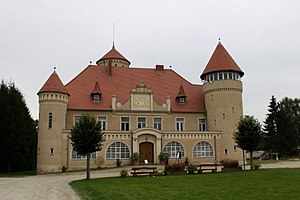Stumble on Usedom
| coat of arms | Germany map | |
|---|---|---|

|
Coordinates: 53 ° 52 ' N , 14 ° 0' E |
|
| Basic data | ||
| State : | Mecklenburg-Western Pomerania | |
| County : | Vorpommern-Greifswald | |
| Office : | Usedom-South | |
| Height : | 0 m above sea level NHN | |
| Area : | 14.86 km 2 | |
| Residents: | 355 (Dec. 31, 2019) | |
| Population density : | 24 inhabitants per km 2 | |
| Postal code : | 17406 | |
| Area code : | 038372 | |
| License plate : | VG, ANK, GW, PW, SBG, UEM, WLG | |
| Community key : | 13 0 75 129 | |
| Office administration address: | Markt 1 17406 Usedom |
|
| Website : | ||
| Mayor : | Falko Beitz ( SPD ) | |
| Location of the municipality of Stolpe on Usedom in the Vorpommern-Greifswald district | ||
Stolpe auf Usedom is a municipality near the town of Usedom on the island of the same name, directly on the banks of the Szczecin Lagoon . The municipality is administered by the Usedom-Süd office based in the city of Usedom . Until 2005 the community belonged to the Ahlbeck to Stettiner Haff district .
Geography and traffic
Stolpe auf Usedom is located on the north bank of the Szczecin Lagoon south of the federal road 110 (B 110) in the middle of the Usedom Island Nature Park . The community has a port on the lagoon. About five kilometers west of the municipality is the city of Usedom and 15 kilometers north of the municipality of Heringsdorf .
Until 1945 the place had a train station on the Ducherow – Heringsdorf line .
Community structure
- Districts
- Gummlin
- Stumble
- Desolations and living spaces
- Diki (desert)
- Lapwing pitcher (living space)
From 1945 to 1952 the community, with the part of the district of Usedom-Wollin that remained in Germany after the Second World War, formed the district of Usedom in the state of Mecklenburg . This was in 1952 in the district of Wolgast in District Rostock on. The community has belonged to the state of Mecklenburg-Western Pomerania since 1990. Since 1994, Stolpe has belonged to the district of Ostvorpommern , which was added to the district of Vorpommern-Greifswald in 2011 .
history
Stumble
The area around Stolpe on Usedom was settled early on, as can be seen from many early and prehistoric finds. 2.5 km north of Stolpe, south of the B 110, there is a Slavic castle, a Niederungsburg. The two-part system can still be seen on the satellite image. The visible remains are the castle's former moat system. There was an oval, almost square main castle, which was surrounded by an arch like a southern bailey. The north-south extension of the entire castle complex is approx. 120 m with a moat. Such castles were typical of the region in the Middle and Yaroslav times and were the residences of local Slavic noblemen and court (craftsmen, guards, merchants, etc.). Such castles certainly served the population as refuge even in times of war.
A short distance from this rampart is an early German tower hill castle (from 1230), which was probably built for the locator during the German eastward expansion. Another of these hill towers is located near the site, in what will later be the manor park. This is where the locator's seat was certainly relocated, because the local conditions there were better for the establishment of a mansion.
Stolpe was first mentioned in a document in 1218 as "Stolp". In the deed, Duke Bogislaw II allows the Grobe monastery to purchase arable land. The witness was a Thomas, a priest in Stolpe . The place name is derived from the Old Slavic word stlŭpŭ for column or "fish stand in the river", a device for fishing.
In the 1330s Martin von Winterfeld on Kagenow and the Plötzenburg (Plötz near Jarmen) sold part of his property on Usedom, including lands near Stolpe and Dargen, and bequeathed the proceeds to the Pudagla Monastery as a foundation .
From 1251 to 1754 the von Schwerin family owned the estate with an independent branch; then the families Gregorius Friedrich von Schmalensee (until 1783), von Lepel (until 1794), Krauthoff (until 1835), Vogel (until 1865) and Bernhard Graf von Schwerin and Erben (1895 until 1945). Schloss Stolpe of 1590 from the Renaissance was baroque and 1895 historicizing rebuilt.
The village is an angerdorf with a village pond, churchyard and church. South of the Angers was the dominant estate with a castle and northeast of the church was the village with the farm workers and craftsmen's cottages. To the south-east of the property was a large castle park, which is now much smaller and overgrown.
In 1648, after the Peace of Westphalia , Stolpe on Usedom became Swedish like all of Pomerania, and after the Peace of Stockholm on February 1, 1720, it became Prussian property. After the administrative reform in 1815, Stolpe came to the Prussian province of Pomerania and belonged to the district of Usedom-Wollin from 1818 to 1945 .
From 1835 to 1880 the village had expanded considerably, especially around the Anger, two windmills were built on site and a brick factory on the Achterwasser. These commercial facilities disappeared around 1920. In 1880, the village received a railway connection 1.5 km north with a stop on the Ducherow-Swinemünde route. Opposite the church in the castle park, a separate grave complex for the von Schwerin family was laid out, which is still there today.
At the end of the Second World War , the castle, estate and church were looted.
With the land reform of 1945, the estate was settled and given to new farmers, especially to refugees and displaced persons from Pomerania and East Prussia. At first they lived in the castle and the adjoining manor buildings, later the new farms were built, which further enlarged the place. The administration of the local MTS and the community facilities were later housed in the castle.
The last noble owner of the estate, Freda Countess von Schwerin, expropriated in 1945, died in Lüneburg in 1957 . The circumstances of her burial in Stolpe were processed literarily by Wolfgang Kohlhaase in 1977 and filmed by Heiner Carow in 1992 as the funeral of a countess .
In addition to the castle, the relatively large stables have been preserved, the other manor buildings are not as attractive. The place has developed into a tourist magnet, especially because of the now extensively restored castle. Otherwise the area is more dominated by agriculture.
Gummlin
Gummlin was first mentioned in 1282 as "Chummelyn". The place was often mentioned chronically and in documents. The name of the Slavic foundation is interpreted as "grave mound" but also as "threshing floor, threshing floor".
Gummlin is a street village from the form, a farming and fishing village from the function. It is right on the lagoon. Several settlements were spread out in the Feldmark, including the "Kiebitz-Krug" which was known at the time and belonged to Gummlin.
On July 1, 1950, Gummlin was incorporated.
Diki (desert)
Diki was first mentioned as such in 1317. After that there were no more mentions, the place fell desolate. The name is interpreted as a Slavic foundation with "wild". It was near Gummlin.
Lapwing pitcher (living space)
Kiebitzkrug was first mentioned in 1575 as "Kivitzkrugk". The name is self-explanatory - lapwing = the bird, jug = the restaurant. Several spellings existed until 1906. The place is on the road between Stolpe and Gummlin. In ancient times it was described as a farmer's cottage, the owner of which could neither live from agriculture nor from the jug, so both as a sideline. In the maps from 1835 (PUM) to 1920 ( MTB ) the property is always indicated as an independent place. It is still a separate place to live with a compact farm. The living space belongs to Stolpe, but is not considered a district according to the statutes.
politics
mayor
In the municipal elections in Mecklenburg-Western Pomerania in 2019 , Falko Beitz ( SPD ) was elected honorary mayor of the municipality of Stolpe on Usedom with 77.1%.
Community representation
| Political party/
Voter group |
Local election 2014 | Local elections 2019 |
|---|---|---|
| Voting community (WG) Stolpe / Gummlin | 6th | 4th |
| Single applicant Büstrin | nk | 1 |
| Single applicant Wiedemann | nk | 1 |
Coat of arms, flag, official seal
The municipality has no officially approved national emblem, neither a coat of arms nor a flag . The official seal is the small state seal with the coat of arms of the region of Western Pomerania . It shows an upright griffin with a raised tail and the inscription "GEMEINDE STOLPE AUF USEDOM * LANDKREIS VORPOMMERN-GREIFSWALD".
Attractions
→ See also the list of architectural monuments in Stolpe on Usedom
- Neo-Gothic village church from 1871
- Stolpe Castle from the High Renaissance from 16./17. century
- Stolpe tower hill
Personalities
- Erdmann Friedrich von Schwerin (1704–1753), district administrator
- Carl Magnus von Schwerin (1715–1775), Prussian general
Web links
swell
- ↑ Statistisches Amt MV - population status of the districts, offices and municipalities 2019 (XLS file) (official population figures in the update of the 2011 census) ( help ).
- ↑ a b c Manfred Niemeyer: Ostvorpommern I . Collection of sources and literature on place names. Vol. 1: Usedom. (= Greifswald contributions to toponymy. Vol. 1), Ernst-Moritz-Arndt University of Greifswald, Institute for Slavic Studies, Greifswald 2001, ISBN 3-86006-149-6 . P. 12 ff
- ^ Paul Kühnel: The Slavic place names in Meklenburg. In: Yearbooks of the Association for Mecklenburg History and Archeology. Vol. 46, 1881, ISSN 0259-7772 , pp. 3-168, here p. 138.
- ^ Hans Josef Graf von Schwerin: Countess Freda von Schwerin, b. from Kleist. In: Stolpe Castle on Usedom - history and future. (= Usedom-Wolliner Blätter 4th ISSN 1611-3322 ), 2nd edition, Störr, Ostklüne 2010, ISBN 3-937040-03-X , pp. 9-12.
- ↑ Announcement of the final election result and the name of the selected applicant: Direct election of the mayor in the municipality in the municipality of Stolpe on Usedom on May 26, 2019. June 3, 2019, accessed on August 13, 2019 .
- ↑ Announcement of the final election results and the names of the candidates elected in the municipal elections in Mecklenburg-Western Pomerania on May 25, 2014. Usedom-Süd office, May 28, 2014, accessed on August 13, 2019 .
- ↑ Announcement of the final election results and the names of the candidates elected for the municipal elections in Mecklenburg-Western Pomerania on May 26, 2019. Usedom-Süd office, June 4, 2019, accessed on August 13, 2019 .
- ↑ Main Statute, Section 1, Paragraph 3 (PDF).



